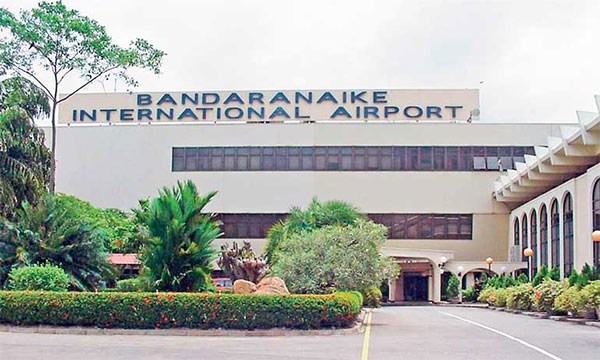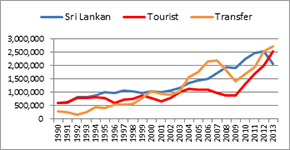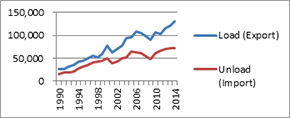| Bandaranaike Airport Expansion Project, International Gateway to Sri Lanka - by Eng. S. M. R. Rafeek and Eng. M. G. Hemachandra |
| |
 |
| Image : www.ft.lk |
| |
|
Background
|
| |
|
Bandaranaike International Airport (BIA) is Sri Lanka’s biggest Airport and main gateway to the world. BIA would act as a regional and national economic motor, as it creates necessary infrastructure for wide range of economic activities, as access to markets and international transport links are vital for economic development. On the other hand Sri Lanka as an island country will immensely benefit for regional cooperation and social inclusion.
Bandaranaike International Airport (BIA) is one of the busiest cargo and passenger airports in the south Asian Region receiving over 29 airlines serving about 45 destinations worldwide, including 20 in the region. The Bandaranaike International Airport handled 8.6 million passengers by November 2016 and exceeded its capacity of 6 mppa. The BIA experience congestion during peak hours thus causing hardship to passengers and airliners and the new passenger terminal building is greatly awaited.
|
| |
| History of BIA Development |
| |
| From 1930 -1981 |
| |
|
Sri Lanka’s civil aviation industry was born in the 1930’s with the construction of an aerodrome in Ratmalana and it was operational in 1935.
Bandaranaike International Airport was first built by British in the mid 1940’s was primarily used for air force base and supply center for aircrafts engaged in World War II.
With assistance from the government of Canada, airport was developed for handling 150,000 passengers per annum and operation was started in 1968. Airport was further developed in year 1978 under UNDP assistance.
In 1981, the Master Plan for Bandaranaike Airport was developed with the assistance of the Government of Netherland.
|
| |
| From 1981 - 2006 |
| |
|
Government of Japan assisted further development of airport with all required facilities for catering annual handling capacity of 3.5 million passengers and was operational since 1988.
Japanese government extended further cooperation for expansion of airport which paved the way for meeting the competition in the aviation sector at that time. The development brought state of the art pier building with eight contact gates and 14 Nos. Passenger Boarding Bridges for the first time in the history of Sri Lanka. The project was completed in 2005 by giving enhanced capacity of handling 6 million passengers per annum.
|
| |
| After 2006 - Recent Development in Sri Lankan Economy and Airport Operation |
| |
| After ending internal conflict of Sri Lanka in the year 2009 which hindered the growth of the economy for about 30 years, Sri Lankan economy started growing in many facets. Foreign tourist arrivals in 2010 increased nearly by 50%, compared to the previous year 2009. Considering the increase of demand, the new Terminal-2 of the airport was designed to cater another 9 mppa. and with that expansion, the capacity of airport will be increased up to 15mppa. Government of Japan through JICA is supporting for expansion of airport with financing JPY 74,397 million (approx. Rs. 95 billion). |
| |
 |
|
 |
| Fig -1 GDP per capita growth Projection: the conducive economic policies will further strengthen this projection |
|
Fig-2 8.5 million passengers were handled in year 2015. The capacity of the airport is 6 MPPA. The capacity has already exceeded. |
| |
|
|
 |
|
 |
| Fig -3 Tourist arrival and Transfer passengers’ shows drastic increase since 2009. |
|
Fig -4 Cargo handling is in increasing trend. BIA is becoming a one of the pivotal point in regional as well as international supply chain. |
| |
|
|
 |
|
|
| Fig -5 Aircraft Movement has been increasing in trend |
|
|
| |
|
|
|
Proposed Facilities under Airport Expansion Project and Expected Improvement in Airport Operation.
|
| |
|
Scope of the new project includes construction of a multi-level terminal building with two pier buildings, Elevated roadway, construction of a new parking apron with 23 stands, taxiways, multi storey car park, new sewerage treatment plant, solid waste disposal incinerator, water treatment plant. Total scope has been divided in to two contract packages. The proposed new Terminal 2 concept is that arriving and departing passengers are vertically separated in all aspect. Departing passengers are processed on the upper level and the arrival passengers on the lower level.
The new terminal will also provide facilities for operation of new large aircraft A 380 by providing two contact gates with two stories Gangway Bridge.
Sustainability is a key focus of the new Terminal 2. Many environmentally friendly initiatives have been incorporated in the design to promote energy efficiency while mitigating adverse environmental effects. The new terminal shall use natural day light and natural ventilation to minimize energy use. Low E glass has been proposed to limit heat gain and lighting controls to reduce energy use. Sensor operated taps urinals and water saving type sanitary fittings have been proposed to reduce water usage.
Universal design features have been incorporated to assist people with different disabilities.
|
| |
| Impact due to Airport Activities |
| |
|
Impact due to Airport Activities With expansion of airport, BIA would create more job opportunities by creating jobs for over 30,000 people directly and indirectly. Moreover the BIA will also influence the regional development while improving the connectivity within the region. Sri Lanka as an island, airport is the gateway to the country and has paramount importance in the aspects of economic, social and cultural development. It will contribute to the economic development by increasing speed of trade with possible increase in amount of imports & exports due to faster means of transportation, and supporting the tourism industry. It will also contribute to the social and cultural development by bringing in foreign culture and promote local culture to visitors, create faster enabling environment for more communication with rest of the world, enable more information inflow & outflow, and increase in people’s mobility.
|
| |
| By |
| |
|
1. Eng. S. M. R. Rafeek, Head of Projects /AASL, MSc ( Engineering), Chartered civil Engineer
|
| |
| 2. Eng. M. G. Hemachandra, Project Specialist, JICA (Chartered Civil Engineer, MBA in Infrastructue, B.Sc. Eng. (Hons), Dip. in Management, Dip. in Commercial Arbitration) |
| |
|
 |
| |
| "All Council Members can be contacted via email or phone by first login as a member to MyIESL and then acceding the Council Directory. It is also possible to communicate your concerns from anywhere in the world by posting them to the Forum - Meet The President and Council from the Forum page" |
| |
|